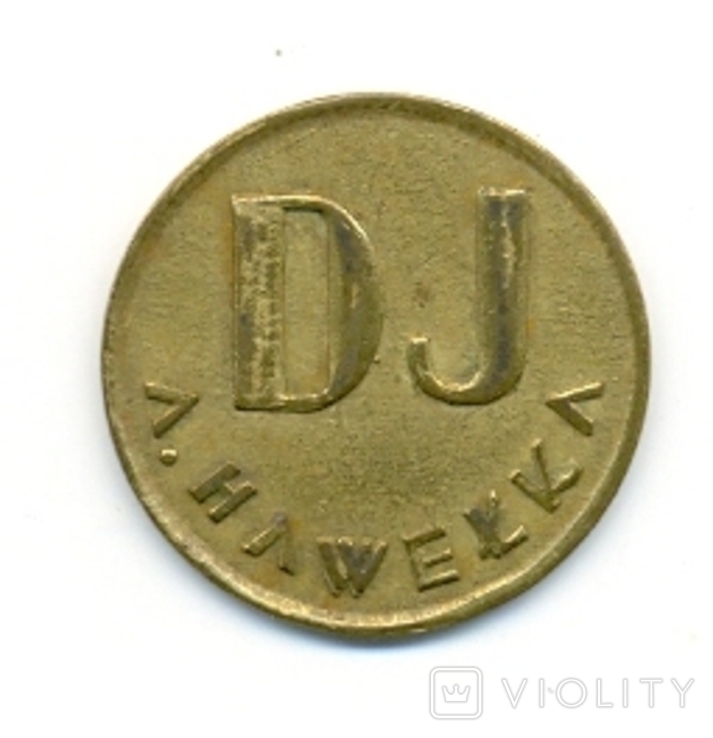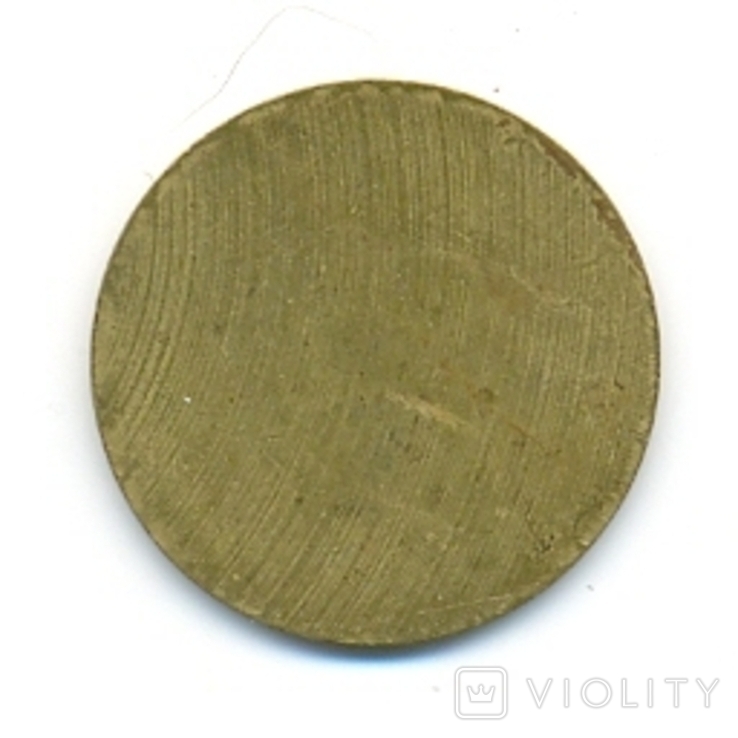To participate in discussions you need to log in.
Login
Token of Polish restaurateurs. (etony kelnerskie). Krakow, beg. Twentieth century.
Rates:
0
0
Max bid:
0 UAH
0 UAH
Added:
18.04.2024, 20:24
18.04.2024, 20:24
Watching the lot: 1 people
Added:
18.04.2024, 20:24
18.04.2024, 20:24
Ending
23.04.2024, 20:24:13 +5m
Until the end
Current price (0 bids)
10
USDMetal:
Material:
Metal
метал
Condition:
As in the photo
як на фото
Restoration:
no
ні
Defects:
Show originalno
ні
Location:
Ukraine, Lviv oblast, Lviv
Payment:
PrivatBank
Sending lot to:  Ukraine,
Ukraine, The whole world
The whole world
 Ukraine,
Ukraine, The whole world
The whole worldDelivery:
Nova Poshta, Ukrposhta (according to the current legislation of the seller's country of residence).
Description:
Kellner tokens (żetony kelnerskie) have been used by Polish restaurateurs since the end of the XIX century. Their main function was to settle between the Kellner waiters and the cashier of the buffet and restaurant. These tokens were in circulation in small cafes, pastry shops, bars, as well as in expensive restaurants or cheap pubs.
In large restaurants, special cash registers were organized, in which dishes, snacks and drinks were evaluated by means of tokens (such as the brand tokens presented below, such as, for example, the tokens of the famous Krakow restaurant A. Hawełka). In small restaurants that did not have special cash registers, such tokens served to actually calculate the kellner with a buffet and kitchen.
In practice, it looked like starting work in the morning, the kellner received tokens of various denominations from the owner of the restaurant, for which he signed in the corresponding book. The tokens were stored in a special leather handbag on the belt, or hanging over the shoulder. When a customer placed an order, the kellner paid for a dish or drink in the buffet or kitchen with tokens, and the client himself paid the kellner in cash. In the evening, after work, the revenue was calculated: a separate buffet, a separate kitchen, and a separate kellner services.
Kellner had both unused tokens and cash in his purse, and only used tokens in the buffet and kitchen. Kellner settled with the owner, giving him cash plus unused tokens, the number of which was to converge with the quota that was indicated at the beginning of the day in the book. The owner also paid him 10% plus a tip. Then the owner of the restaurant settled with the bartenders and chefs - the buffet and the kitchen.
The decoding of abbreviations on tokens is not fully defined. Perhaps these are beer tokens, for example, D J - "duże jasne".
The diameter of the token is 25 mm.
https://www.liveinternet.ru/community/moja_polska/...
Payment for the payment is carried out by the buyer.
In large restaurants, special cash registers were organized, in which dishes, snacks and drinks were evaluated by means of tokens (such as the brand tokens presented below, such as, for example, the tokens of the famous Krakow restaurant A. Hawełka). In small restaurants that did not have special cash registers, such tokens served to actually calculate the kellner with a buffet and kitchen.
In practice, it looked like starting work in the morning, the kellner received tokens of various denominations from the owner of the restaurant, for which he signed in the corresponding book. The tokens were stored in a special leather handbag on the belt, or hanging over the shoulder. When a customer placed an order, the kellner paid for a dish or drink in the buffet or kitchen with tokens, and the client himself paid the kellner in cash. In the evening, after work, the revenue was calculated: a separate buffet, a separate kitchen, and a separate kellner services.
Kellner had both unused tokens and cash in his purse, and only used tokens in the buffet and kitchen. Kellner settled with the owner, giving him cash plus unused tokens, the number of which was to converge with the quota that was indicated at the beginning of the day in the book. The owner also paid him 10% plus a tip. Then the owner of the restaurant settled with the bartenders and chefs - the buffet and the kitchen.
The decoding of abbreviations on tokens is not fully defined. Perhaps these are beer tokens, for example, D J - "duże jasne".
The diameter of the token is 25 mm.
https://www.liveinternet.ru/community/moja_polska/...
Payment for the payment is carried out by the buyer.
Кельнерские жетоны (żetony kelnerskie) использовались польскими рестораторами с конца XIX века. Их основная функция заключалась в расчете между официантами-кельнерами и кассой буфета и ресторана. Эти жетоны были в обращении в небольших кафе, кондитерских, барах, а также в дорогих ресторанах или дешевых пивных.
В крупных ресторанах были организованы специальные кассы, в которых посредством жетонов оценивались блюда, закуски и напитки (к таким относятся представленные ниже брендовые жетоны, такие, как, например, жетоны знаменитого краковского ресторана А. Хавелка (А. Hawełka). В небольших ресторанах, не имеющих специальных касс, такие жетоны служили собственно для расчета кельнера с буфетом и кухней.
На практике это выглядело так, что приступая к работе утром, кельнер получал от хозяина ресторана жетоны различного номинала, за которые расписывался в соответствующей книге. Жетоны хранились в специальной кожаной сумочке на поясе, либо висящей через плечо. Когда клиент делал заказ, кельнер платил за блюдо или напиток в буфете или кухне жетонами, а сам клиент рассчитывался с кельнером наличными. Вечером после работы подсчитывалась выручка: отдельно буфет, отдельно кухня, отдельно услуги кельнера.
У кельнера в сумочке были как неиспользованные жетоны, так и наличная выручка, а в буфете и кухне – только использованные жетоны. Кельнер рассчитывался с хозяином, отдавая ему наличку плюс неиспользованные жетоны, количество которых должно было сойтись с той квотой, что была указана в начале дня в книге. Ему же хозяин уплачивал 10% плюс чаевые. Затем хозяин ресторана рассчитывался с барменами и поварами - буфетом и кухней.
Расшифровка сокращений на жетонах не до конца определена. Возможно, это пивные жетоны, например, D J – «duże jasne».
Діаметр жетона - 25 мм.
https://www.liveinternet.ru/community/moja_polska/post147669146/
Оплату за відправлення проводить покупець.
Link to the discussion:
Show originalThe basic language of the Site is Ukrainian. Translation from other languages is brought to you by automatic machine translation.
Dear Users, please be advised that the machine translation may be not accurate. In case of complains regarding the accuracy of the translation, the original text posted by the Seller has the upper hand.


Seller's other lots
Report about violation to moderator
Please select the type of violation from the list:
How does AUTO BIDDING work
This is a function that helps you place bids automatically in case your bet is interrupted.
For example, current lot price is UAH 120. You are ready to bargain up to UAH 5 000. Enter 5 000 in the field "Automatic bargaining" and click "Place Bet". As a result, your new rate will appear, but not in the amount of UAH 5 000, but only UAH 121. In this case, the system will remember that you are ready to bargain up to UAH 5 000, and will make the necessary bids for you if the price continues to rise.
Let's say another participant places a bet of UAH 2 000. Then the system will automatically place your bet of 2 001 UAH. And only if someone places a bet more than UAH 5 000, you will receive a notification that your auto rate has been interrupted.
For example, current lot price is UAH 120. You are ready to bargain up to UAH 5 000. Enter 5 000 in the field "Automatic bargaining" and click "Place Bet". As a result, your new rate will appear, but not in the amount of UAH 5 000, but only UAH 121. In this case, the system will remember that you are ready to bargain up to UAH 5 000, and will make the necessary bids for you if the price continues to rise.
Let's say another participant places a bet of UAH 2 000. Then the system will automatically place your bet of 2 001 UAH. And only if someone places a bet more than UAH 5 000, you will receive a notification that your auto rate has been interrupted.
Comments 0